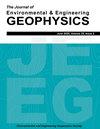Numerical Study on Urban Infrastructure Diagnosis in Laterally Heterogenous Soils Using Resistivity and Ground Penetrating Radar Techniques
IF 0.7
4区 工程技术
Q4 ENGINEERING, GEOLOGICAL
引用次数: 0
Abstract
Urban environment can be considered a complex system consisting of the engineered pavement physical structure over the buried utilities (water, gas, sewer) network embedded in the background soil environment. Assessment of buried pipeline civil infrastructures using proximal geophysical methods in such instances has to consider possible interferences, difficulties, and incorrect inferences. In this study, we have conducted a numerical modelling investigation to understand and evaluate how electrical resistivity profiling (ERP) and ground penetrating radar (GPR) can be utilised to provide subsurface information that otherwise may not be possible if either one of the techniques is used. A model geometry consisting of a typical pavement structure (asphalt, base/subbase, and background soil) with a single 2 m pipe buried at a depth of 1 m was used. Strong lateral variations in soil type were incorporated over the short pipe section in order to understand the complexities that can arise, especially with ERP measurements. The 3D electrical resistivity measurements were simulated in Comsol using the 4-probe method, while the 2D GPR measurements were simulated in gprMax to obtain the subsurface information. The results from both ERP and GPR were used to develop a practical framework that can be utilised by relevant authorities for proximal condition assessment of their buried assets. It was suggested that ERP can be used as a first level screening tool over the whole pipeline length, followed by discretely selected GPR scans in order to further gain information on the pipe health. This is attractive practically since, following delineations of a large pipe section into shorter subsections, advanced condition assessment approaches that are generally intrusive in nature can then be economically deployed within the subsections suspected of experiencing significant corrosion damage.基于电阻率和探地雷达技术的横向非均质土壤城市基础设施诊断数值研究
城市环境可以被认为是一个复杂的系统,由工程路面物理结构组成,覆盖在嵌入背景土壤环境的地下公用设施(水、气、下水道)网络上。在这种情况下,使用近地地球物理方法评估埋地管道民用基础设施必须考虑可能的干扰、困难和不正确的推断。在这项研究中,我们进行了数值模拟调查,以了解和评估如何利用电阻率剖面(ERP)和探地雷达(GPR)来提供地下信息,否则如果使用其中任何一种技术都可能无法实现。模型几何结构由典型的路面结构(沥青、基层/基层和背景土)和埋在1米深的一根2米长的管道组成。为了了解可能出现的复杂性,特别是ERP测量,在短管段上考虑了土壤类型的强烈横向变化。三维电阻率测量在Comsol中采用4探针法进行模拟,二维探地雷达测量在gprMax中进行模拟,获得地下信息。ERP和GPR的结果被用来开发一个实用的框架,相关当局可以利用该框架对其埋藏资产进行近距离评估。有人建议,ERP可以作为整个管道长度的一级筛选工具,其次是离散选择的探地雷达扫描,以进一步获得管道健康状况的信息。这实际上很有吸引力,因为在将大管段划分为较短的分段之后,通常具有侵入性的先进状态评估方法可以经济地部署在可能遭受严重腐蚀损害的分段中。
本文章由计算机程序翻译,如有差异,请以英文原文为准。
求助全文
约1分钟内获得全文
求助全文
来源期刊

Journal of Environmental and Engineering Geophysics
地学-地球化学与地球物理
CiteScore
2.70
自引率
0.00%
发文量
13
审稿时长
6 months
期刊介绍:
The JEEG (ISSN 1083-1363) is the peer-reviewed journal of the Environmental and Engineering Geophysical Society (EEGS). JEEG welcomes manuscripts on new developments in near-surface geophysics applied to environmental, engineering, and mining issues, as well as novel near-surface geophysics case histories and descriptions of new hardware aimed at the near-surface geophysics community.
 求助内容:
求助内容: 应助结果提醒方式:
应助结果提醒方式:


